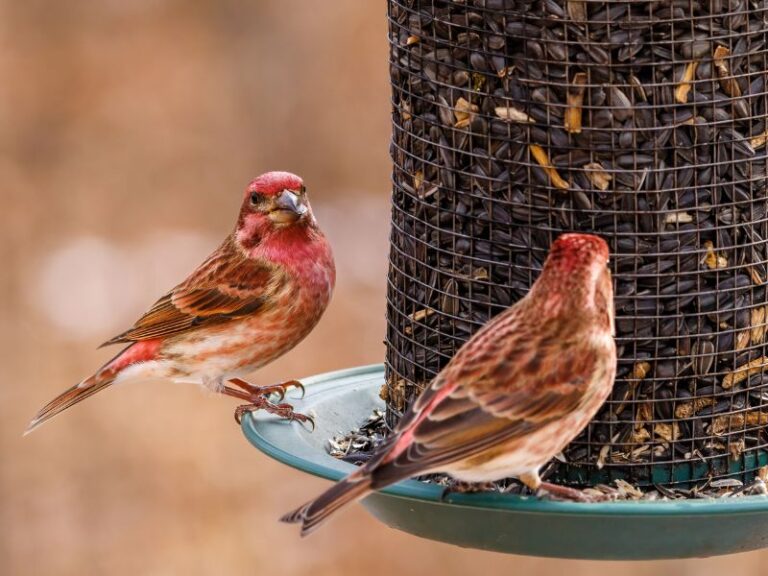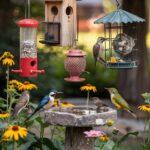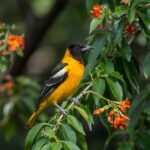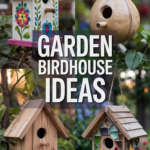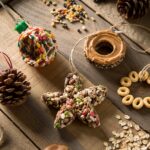Are you feeding your backyard birds all wrong? A lot of bird lovers slip up in ways that actually harm the local wildlife or just chase them away.
Feeding birds the right way brings more species to your yard and helps keep them healthy, especially when it matters most.
When you set up feeders, you’re basically starting a relationship with your local wildlife—and, honestly, that comes with some responsibility. Choosing the wrong seeds, putting feeders in awkward spots, or just not paying attention can frustrate you and the birds.
Let’s run through some common mistakes and how to fix them so your backyard becomes a bird hangout everyone (with wings) wants to visit.
1) Overfilling the Feeder — Too much seed attracts pests and wastes food, so refill in small amounts.
Ever dumped a whole bag of seed into your bird feeder, thinking more is better? Been there! But honestly, it’s one of the biggest mistakes in bird feeding.
When feeders are crammed full, a lot of seed just sits there. Rain or humidity turns it moldy or spoiled, and that’s a recipe for sick birds. Not great.
Overflowing feeders also call in the wrong crowd—mice, rats, raccoons. They’ll show up for the buffet and scare off the birds you actually want around.
Birds are picky eaters, too. They’ll toss aside what they don’t like, so an overfilled feeder means more waste on the ground and more cleanup for you.
So, just fill your feeders halfway or less and top them off with fresh seed more often. The birds will appreciate it (and probably show up more often, too).

2) Neglecting Feeder Cleaning — Dirty feeders spread mold and disease; clean weekly with a bleach solution.
Let’s be real—cleaning bird feeders isn’t the most glamorous chore, and it’s easy to forget. But dirty feeders can actually hurt the birds you’re trying to help.
Wet seeds turn into a mold factory, and with bird droppings mixed in, it’s a perfect storm for spreading disease.
Luckily, cleaning isn’t complicated. Scrub with hot water and a bottle brush once a week. For a deeper clean, use a mild bleach solution (one part bleach to nine parts water), then rinse really well.
Skip the dish soap—leftover residue can be harmful. Let everything dry out before you refill.
Picture this: A person wearing rubber gloves at an outdoor sink, scrubbing a bird feeder with a bottle brush. Nearby sits a small container of bleach solution, with clean feeders drying on a rack in the sunshine.
3) Using the Wrong Seeds — Black oil sunflower seeds are best for minimal mess and broad bird appeal.
Grabbed the cheapest bird seed at the store? I get it, but it’s a common mistake! Black oil sunflower seeds are the real MVPs for most backyard birds.
These seeds have thin shells, so even small birds can crack them open. That means more birds can eat with less mess left behind.
Christopher Ingraham points out that black oil sunflower seeds are “by far the favorite food of the widest variety of birds.” You’ll see more species just by switching to this one seed.
Mixed bags usually have fillers like milo and cracked corn. Most birds ignore these, so they end up as waste—and sometimes as rodent snacks.
Picture this: A clear tube feeder filled with glossy black oil sunflower seeds, with various colorful birds perched around it, shells neatly cracking as cardinals, chickadees, and finches eagerly feed.
4) Ignoring Feeder Placement — Placing feeders too close to windows risks bird collisions; keep them visible and safe.
Ever found a dazed bird by your window? Feeder placement might be the problem! Birds don’t always see glass and can slam right into it if startled.
Feeders set between 3 and 15 feet from windows create a danger zone—birds get up enough speed to really hurt themselves if they hit the glass.
Instead, put feeders really close (within 3 feet) or much farther away (over 15 feet). Up close, birds can’t build up speed, so collisions (if they happen) aren’t as bad.
Try adding decals or strings to your windows, too. Simple visual markers can help birds realize there’s a barrier there.
Picture this: A bird feeder mounted directly on a window with suction cups, with several birds safely feeding just inches from the glass, while other feeders hang from tree branches at least 20 feet away from the house.
5) Starting Feeders Suddenly — Introduce feeders gradually where birds already visit to build trust
Ever set up a shiny new feeder and then… nothing? Not a single bird? Birds are cautious and need time to trust new things in their territory.
It’s a bit like making friends—trust takes time. Put your feeder where you’ve already seen birds hanging out. Sprinkle a little seed on the ground nearby so they associate the area with food.
As birds get comfortable grabbing snacks from the ground, they’ll start checking out the feeder. Don’t stress if it takes a while. Once a few brave birds show up, word gets around fast!
Picture this: A garden scene showing a bird feeder with seed scattered on the ground beneath it, where chickadees are feeding on the ground while eyeing the feeder curiously from a safe distance.
6) Choosing Inadequate Feeders — Pick sturdy, weatherproof feeders that keep seeds dry and deter squirrels
Are you setting the birds up for disappointment with a flimsy feeder? The right feeder really does make a difference.
Look for feeders that can stand up to rough weather and keep seeds dry. Those cheap plastic models? Squirrels can tear them apart, and cold snaps crack them in no time.
Go for metal ports and reinforced perches—squirrels have a bad habit of chewing through plastic. Birds deserve better than soggy or scattered seeds.
Choose feeders that are easy to clean and refill. Detachable roofs and clear windows are handy for checking seed levels without a hassle.
Squirrel baffles help, too. These cone-shaped guards stop squirrels from climbing up and raiding your feeder. The birds (and you) will appreciate fewer squirrel shenanigans.
Picture this: A sturdy metal bird feeder with a transparent seed chamber mounted on a pole with a cone-shaped baffle. Birds happily feed while a frustrated squirrel sits on the ground below, unable to climb past the baffle.
7) Leaving Feeders Out Year-Round — Seasonal feeding helps birds without creating dependency or excess waste
Keeping feeders full all year might sound like a good idea, but it’s not always what birds need. Nature changes with the seasons, and so do birds’ diets.
In summer, most birds switch to insects and natural seeds. Your store-bought seed just sits there, getting moldy and attracting pests.
Focus on feeding in winter and early spring, when food is scarce. Don’t stress about birds becoming dependent—research shows even in winter, they get most of their food elsewhere.
Taking feeders down in warmer months gives you a chance to deep clean and saves you money on uneaten seed.
Picture this: A split-screen image showing a snow-covered bird feeder bustling with activity on one side, and the same feeder in summer with fewer birds as they forage for natural food in nearby flowering plants and trees.
8) Not Removing Moldy Seeds — Moldy or spoiled seed can make birds sick; always discard old seed promptly.
Checked your feeder lately? Sometimes old seeds at the bottom turn into a health hazard. Moldy seed is seriously bad news for birds.
Wet or old seeds grow fungus and bacteria, which can make birds sick. You wouldn’t eat moldy bread, right? Don’t let birds eat moldy seeds, either.
Clean feeders regularly and toss out wet or clumped seeds. Try to empty and scrub feeders every two weeks in cool weather, and every week when it’s hot and humid.
Rake up fallen seed under feeders, too. Old hulls and scattered seed are perfect for mold growth and can mess up fresh seed when birds kick it around.
Picture this: A close-up of a bird feeder with visible moldy seeds at the bottom, next to a fresh, clean feeder with healthy-looking seeds, showing the stark contrast between proper and improper bird feeding practices.
9) Failing to Monitor Pest Activity — Ants and rodents love feeders too; use designs that limit pest access.
Ever filled your feeder only to find it crawling with ants or raided by mice? It happens! Feeders attract all sorts of guests, not just birds.
Ants love sweet nectar and seeds, and rodents will snack on anything that hits the ground. That wastes seed and spreads germs that can hurt birds.
Try feeders with pest guards or baffles. Ant moats are a game-changer—they create a water barrier ants can’t cross. For mice, hang feeders away from jumping spots and use dome baffles below.
Keep feeders clean, too. Dirty feeders are breeding grounds for bacteria. Check for pests every week or so.
Picture this: A bird feeder with a clear ant moat filled with water, suspended from a branch with a dome-shaped baffle below it, while a small bird enjoys seeds from the clean feeding ports.
Understanding Bird Nutrition
Feeding birds isn’t just tossing out seeds—it’s about giving them the right nutrients so they stay healthy and energetic. Different birds want different things, and knowing what to offer can turn your yard into a bird hotspot.
What Do Birds Need in Their Diet?
Birds need a balanced diet, just like we do! Most backyard birds look for:
- Protein: For muscle and feather growth
- Fats: Vital for energy, especially in winter
- Carbohydrates: Quick energy for daily life
- Vitamins and minerals: For health and immunity
Every species is a little different. Finches love sunflower seeds, warblers need protein-rich snacks, and migrants need high-fat foods before long flights.
Don’t forget water! Birds need fresh water for drinking and bathing. During migration, offer extra fatty foods like suet to help them store energy.
Signs Your Feed Isn’t Meeting Bird Needs
Not seeing many birds lately? That could mean your feed isn’t cutting it. Watch for these signs:
- Birds pick through seeds, tossing them everywhere looking for something better
- Fewer visitors even when the weather’s good
- Feeders stay full for days without much activity
- Regulars look unhealthy (dull feathers, sluggish behavior)
If you notice these, mix things up. Add different feeder types—some birds like platforms, others want tubes or hoppers.
Quality matters, too! Old or moldy seed isn’t just unappetizing; it can make birds sick. Swap out old seed, especially after rain.
Creating a Safe and Inviting Feeding Environment
Setting up feeders takes more than just hanging them wherever. Placement and cleaning actually matter a lot for attracting birds and keeping them safe.
How Feeder Placement Affects Bird Visits
Where you put your feeders can totally change your bird-watching experience. Birds want to feel safe, so keep feeders about 10-12 feet from shrubs or trees. That way, birds have an escape route but predators can’t sneak up easily.
Don’t put feeders too close to windows—collisions are a real risk. The safest bets: within 3 feet (so birds can’t get up speed) or more than 30 feet away.
Height matters, too. Hang feeders 5-6 feet up to keep them out of reach of cats and other ground predators. Some overhead cover helps keep seed dry, too.
Essential Hygiene Practices for Feeders
When did you last clean your feeders? Dirty feeders can spread nasty diseases like salmonellosis or conjunctivitis. Not good.
Cleaning schedule:
- Empty and scrub feeders every 2 weeks
- Clean more often in hot, humid weather
- Clean right away if sick birds show up
Use one part bleach to nine parts water for sanitizing. Rinse well and let everything dry before refilling.
Don’t ignore the ground under your feeders! Seed hulls and droppings pile up fast and can harbor mold or bacteria. Rake often or use a seed tray to catch the mess.
Birdbaths need love, too—change water every 2-3 days and scrub weekly to prevent mosquitoes and algae.
